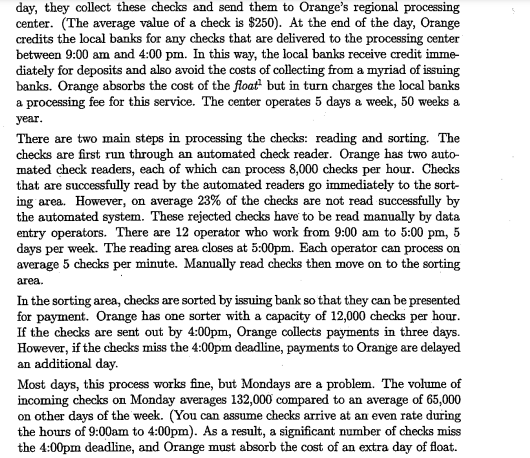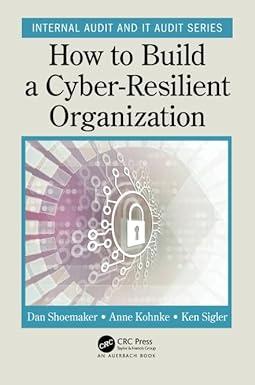


2. Orange Bank provides check processing services for smaller, local banks. The service operates as follows: as local banks receive check deposits throughout the day, they collect these checks and send them to Orange's regional processing center. (The average value of a check is $250 ). At the end of the day, Orange credits the local banks for any checks that are delivered to the processing center between 9:00 am and 4:00 pm. In this way, the local banks receive credit immediately for deposits and also avoid the costs of collecting from a myriad of issuing banks. Orange absorbs the cost of the float 2 but in turn charges the local banks a processing fee for this service. The center operates 5 days a week, 50 weeks a year. There are two main steps in processing the checks: reading and sorting. The checks are first run through an automated check reader. Orange has two automated check readers, each of which can process 8,000 checks per hour. Checks that are successfully read by the automated readers go immediately to the sorting area. However, on average 23% of the checks are not read successfully by the automated system. These rejected checks have to be read manually by data entry operators. There are 12 operator who work from 9:00 am to 5:00 pm, 5 days per week. The reading area closes at 5:00pm. Each operator can process on average 5 checks per minute. Manually read checks then move on to the sorting area. In the sorting area, checks are sorted by issuing bank so that they can be presented for payment. Orange has one sorter with a capacity of 12,000 checks per hour. If the checks are sent out by 4:00pm, Orange collects payments in three days. However, if the checks miss the 4:00pm deadline, payments to Orange are delayed an additional day. Most days, this process works fine, but Mondays are a problem. The volume of incoming checks on Monday averages 132,000 compared to an average of 65,000 on other days of the week. (You can assume checks arrive at an even rate during the hours of 9:00am to 4:00pm). As a result, a significant number of checks miss the 4:00pm deadline, and Orange must absorb the cost of an extra day of float. (a) Draw a process flow diagram of Orange's check processing system. Where is the bottleneck in the process? (b) On average, how many checks miss the 4:00pm deadline on Mondays? (c) Orange is considering purchasing additional equipment. A new check sorting machine costs $250,000 and has useful life of 5 years. Based on the potential savings on float, is this investment justified? Explain. The float is the financing cost caused by the delay in cash flows. Orange pays the local bank rediately, but must wait for payment from the banks that issue the checks. Currently, Orange 8 an annualized rate of 4.5% for funds used to finance this float. Assuming 365 days per year, this esponds to a rate of 4.5%/365=0.0123% per day. 2. Orange Bank provides check processing services for smaller, local banks. The service operates as follows: as local banks receive check deposits throughout the day, they collect these checks and send them to Orange's regional processing center. (The average value of a check is $250 ). At the end of the day, Orange credits the local banks for any checks that are delivered to the processing center between 9:00 am and 4:00 pm. In this way, the local banks receive credit immediately for deposits and also avoid the costs of collecting from a myriad of issuing banks. Orange absorbs the cost of the float 2 but in turn charges the local banks a processing fee for this service. The center operates 5 days a week, 50 weeks a year. There are two main steps in processing the checks: reading and sorting. The checks are first run through an automated check reader. Orange has two automated check readers, each of which can process 8,000 checks per hour. Checks that are successfully read by the automated readers go immediately to the sorting area. However, on average 23% of the checks are not read successfully by the automated system. These rejected checks have to be read manually by data entry operators. There are 12 operator who work from 9:00 am to 5:00 pm, 5 days per week. The reading area closes at 5:00pm. Each operator can process on average 5 checks per minute. Manually read checks then move on to the sorting area. In the sorting area, checks are sorted by issuing bank so that they can be presented for payment. Orange has one sorter with a capacity of 12,000 checks per hour. If the checks are sent out by 4:00pm, Orange collects payments in three days. However, if the checks miss the 4:00pm deadline, payments to Orange are delayed an additional day. Most days, this process works fine, but Mondays are a problem. The volume of incoming checks on Monday averages 132,000 compared to an average of 65,000 on other days of the week. (You can assume checks arrive at an even rate during the hours of 9:00am to 4:00pm). As a result, a significant number of checks miss the 4:00pm deadline, and Orange must absorb the cost of an extra day of float. (a) Draw a process flow diagram of Orange's check processing system. Where is the bottleneck in the process? (b) On average, how many checks miss the 4:00pm deadline on Mondays? (c) Orange is considering purchasing additional equipment. A new check sorting machine costs $250,000 and has useful life of 5 years. Based on the potential savings on float, is this investment justified? Explain. The float is the financing cost caused by the delay in cash flows. Orange pays the local bank rediately, but must wait for payment from the banks that issue the checks. Currently, Orange 8 an annualized rate of 4.5% for funds used to finance this float. Assuming 365 days per year, this esponds to a rate of 4.5%/365=0.0123% per day









